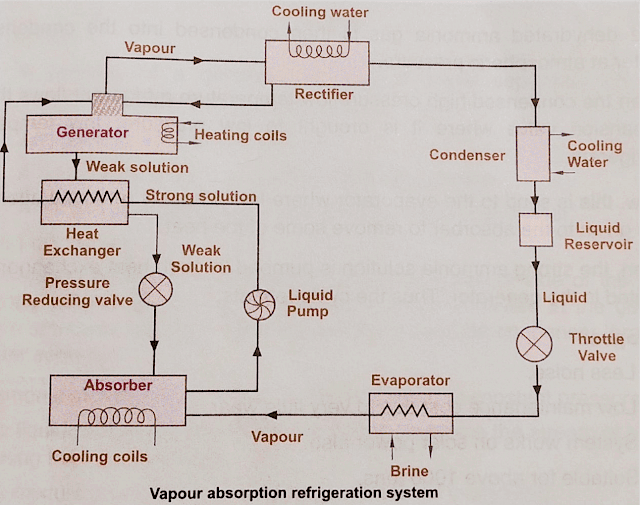Introduction
- The
first vapor absorption refrigeration machine was developed by a French
scientist Ferdinand Carre in 1860.
- The
vapor absorption system uses heat energy, instead of mechanical energy as
in vapor compression, in order to change the conditions of refrigerant
required for the operation of the refrigeration cycle.
- In
the vapor absorption system, the compressor is replaced by an absorber, a
pump, a generator, and pressure reducing valve.
- The
refrigerant and absorbent used are sulphuric acid and water, ammonia and
water.
- In
this cycle ammonia is used as refrigerant and water as absorbent.
Construction
The ammonia (NH3) absorption refrigeration
system consists of a generator, rectifier, condenser, liquid reservoir, throttle
valve, evaporator, water-jacketed absorber, pump.
Generator: It is the place where the refrigerant and absorbent mixture (weak
solution) is heated using an external heat source such as a heating coil or
by solar energy. The temperature of the solution increases and it is converted
into vapor solution. The high-temperature vapor solution leaves the generator
at high pressure.
Rectifier: Rectifier is used to remove
the water vapor from the refrigerant (NH3) so that water vapor does not enter
the condenser and to avoid freezing at the throttle valve. In the rectifier, the
water vapor is cooled and again recirculated to the generator.
Condenser: A condenser is a device that acts as a heat exchanger in the refrigeration system, which
rejects the heat energy of the refrigerant gas gained in the
generator. Atmospheric air and water are the two most convenient
heat sinks to which heat can be rejected. By rejecting heat to the heat sink
high-pressure high-temperature vapor refrigerant is converted into high-pressure low-temperature liquid refrigerant.
Throttle valve: The Throttle valve is also called an expansion valve or metering
device. Used to expand the liquid refrigerant from the condenser pressure to
the evaporator pressure (to maintain a pressure difference). Also
used to control the flow of liquid refrigerant according to the load on the
evaporator. The refrigerant leaves the throttle valve at low-pressure low-temperature liquid refrigerant.
Evaporator: Evaporator
is a cooling chamber in which products are placed. Low-pressure liquid
refrigerant flows in the coils of the evaporator and absorbs the heat from
products. The refrigerant vaporizes and leaves for the absorber.
Absorber: Absorber is the place
where the vapor refrigerant (ammonia) from the evaporator gets cooled and
absorbed by an absorbent (water). Now the vapor refrigerant gets cooled and it
is converted into a liquid solution of refrigerant and absorbent mixture (strong
solution).
Working principle
- Ammonia
vapor is produced in the generator at high pressure (10.5 bar) from the
strong solution of NH3 by external heating.
- Then,
it is passed into the rectifier where the water vapor is removed by
external cooling water circulation.
- The
dehydrated ammonia gas is then condensed in the condenser by water at
atmospheric pressure.
- Then
the condensed high-pressure low-temperature liquid refrigerant flows through
expansion valve where it is brought to low-pressure low temperature
refrigerant.
- Now,
the low-pressure low-temperature refrigerant is sent to the evaporator
where latent heat is removed after which it is given to the absorber to
remove some of the heat.
- Then,
the strong ammonia solution is pumped through a heat exchanger and is heated in the generator. Thus the cycle repeats.
Advantages
- Less
noise
- Low
maintenance cost due to very little wear.
- System
works on solar power also.
- Suitable for above 1000 tons.
- Less
space is required.
Disadvantages
- Its
efficiency is low.
- It
takes a long time to produce the necessary cooling effect.
- Kerosene
oil or gas flame used for supplying heat energy gives out a bad smell.
Types of vapor absorption system
1. Electrolux refrigerator or absorption system.
2. Lithium bromide- water absorption refrigeration system.
3. Solar absorption refrigeration system.


Waooo
ReplyDelete